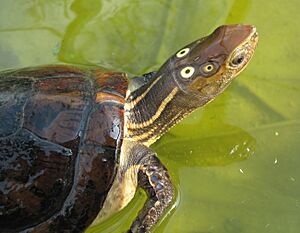Four-eyed turtle facts for kids
Quick facts for kids Four-eyed turtle |
|
|---|---|
 |
|
| Conservation status | |
| Scientific classification | |
| Genus: |
Sacalia
|
| Species: |
quadriocellata
|
| Synonyms | |
|
|
The four-eyed turtle (Sacalia quadriocellata) is a type of reptile called a turtle. It gets its unique name from two bright yellow or green spots on the back of its head. These spots look a lot like an extra pair of eyes!
Contents
Where Do Four-Eyed Turtles Live?
This special turtle lives in several parts of Asia. You can find them in southern China and on Hainan Island. They also live in the Annamite Mountains and northeastern Laos. Plus, they are found in the mountains of northern and central Vietnam.
What Do Four-Eyed Turtles Look Like?
The four-eyed turtle can grow to about 15 centimeters (6 inches) long. This measurement is for its carapace, which is its top shell. Their shells can be yellowish-tan or a deep chocolate-brown. Each turtle also has a cool pattern of lines on its shell.
Their heads are often very colorful. They might have yellow or green eyes and bright yellow stripes. Their throats can even be pink or red! The most amazing part is the two (sometimes four) eye-like spots on the back of their heads. These are called ocelli, and they are why the turtle is named "four-eyed."
How Do Four-Eyed Turtles Live?
Four-eyed turtles prefer to live in freshwater places. This includes streams, small brooks, and ponds. They often live in woodland areas, especially in mountain habitats. Because their homes are often rugged, these turtles are very good at climbing.
Scientists haven't studied their diet in great detail yet. However, we know they eat a mix of plants and animals. Their meals can include crickets, worms, snails, and even special trout food. They also enjoy aquatic plants, green leafy vegetables like lettuce, and some fruits.
Why Are Four-Eyed Turtles Endangered?
The four-eyed turtle is in big trouble. It is listed as Critically Endangered by the IUCN. This means it faces a very high risk of disappearing forever. It's also listed in Appendix II of CITES. This means that international trade of these turtles, or parts of them, is strictly controlled.
A major reason for their decline is the demand for their shells. People use turtle shells as an ingredient in Traditional Chinese Medicine (TCM). For example, the bottom shell, called the plastron, is used in some TCM recipes. Some scientists believe that the top shell (carapace) could be used too. If both parts were used, it could reduce the demand for these turtles by a lot. Also, research suggests that turtle bone from farms works just as well as bone from wild turtles. This could lead to more farm production and less hunting of wild turtles. Scientists are also looking for plant-based alternatives to turtle bone.
Helping Four-Eyed Turtles
Many people are working hard to save these turtles. There are special recovery programs in Vietnam. These programs aim to protect the turtles legally and stop illegal trading. Zoos and conservation groups are working together to make these programs successful.
The Asian Turtle Program (ATP) is also helping. They are part of Indo-Myanmar Conservation. The ATP has a website with the latest news about endangered turtles in Asia. They help spread awareness and support conservation efforts across the continent.


